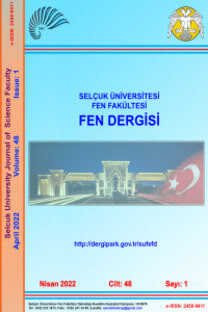Karyotype of Pipistrellus kuhlii (Kuhl, 1819) in Turkey (Mammalia: Chiroptera)
kromozom sayısı, Chiroptera, karyotip, Pipistrellus kuhli, kromozomlar
Türkiye' deki Pipistrellus kuhlii (Kuhl, 1819)' nin karyotipi (Mammalia: Chiroptera)
chromosome number, Chiroptera, karyotypes, Pipistrellus kuhli, chromosomes,
___
[1] Danford, C.G. and Alston, E.R. On the' mammals of Asia Minor. Proc. Zool. Soc, London, 1: 270-281,(1877).[2] Satunin, K.H. Über die zoographischen Grenzen das Kaukasusgebiets. Mit. Kaukas. Mus., Tiflis, 8,(1912).
[3] Strinati, P. Mission coiffait-Strinati en Macedoine, Greece at Turquie (Avril-Mai 1955) Chiroptera. Mammalia, 23: 72-76, (1959).
[4] Kahmann, H. and Çağlar, M. Beitraege zur Saeugetierkunde der Türkei. 1-Fledermause aus der Landschaft Hatay (Eine varlaeufige Mİtteiilung). Istanbul Üniversitesi Fen Fakültesi Mecmuası, Seri B, 25(1-2): 1-21, (1960)
[5] Harrison, D.L The Mammals of Arabia. Insectivora, Chiroptera, Primates. London, 1: 1-192, (1964).
[6] Çağlar, M. Chiropterenfauna der Türkei. I.Ü. Fen Fak. Mec, Seri B, 30 (3-4): 125-134, (1965).
[7] Çağlar, M. Bats of Turkey II. Türk Biol. Derg., İstanbul, 19 (2-4): 88-106, (1969).
[8] Felten, H., Spitzenberger, F. and Storch, G. Zur Kleinsaeugerfauna West-Anatoliens. Teil III a. Senek. Biol., Frankfurt, 58 (1-2): 1-44, (1977).
[9] Helversen, O. Von. New records of bats (Chiroptera) from Turkey. Zool. Middle East, 3: 5-18, (1989).
[10] Albayrak, I. The Bats of Eastern Anatolia and Their Distribution (Mammalia: Chiroptera). Doga Tr. of Zoology, 14 (2): 214-228, (1990).
[11] Albayrak, I. The Bats of Western Turkey and Their Distribution (Mammalia: Chiroptera). Doga Tr. J. of Zoology, 17: 237-257, (1993).
[12] Steiner, H.M. and Gaisler, J. On a collection of bats (Chiroptera) from NE Turkey and N Iran. Acta Sc. Nat. Brno, 28 (1): 1-37, (1994).
[13] Harrison, D.L. and Bates, PJ.J. The Mammals of Arabia. Harrison Zoological Museum, England, 1-345,(1991).
[14] Benda, P. and Horâcek, I. Bats (Mammalia:Chiroptera) of the Eastern Mediterranean. Part I. Review of distribution and taxonomy of bats in Turkey. Acta Soc. Zool. Bohem., 62: 255-313, (1998).
[15] Patton, J. L. Chromosome studies of certain Pocket Mice, genus Perognathus (Rodentia: Heteromyidae). J. Mamm., 48 (1): 27-37, (1967).
[16] Ford C.E., Hamerton, J.L. A colchicine, hypothonic citrate, squash sequence for mammalian chromosomes. Stain Technology, 31 (6):247-251, (1956).
[17] Capanna, E., Civitelli, M. V. I cromosomi de! Pipistrello albolimbato. Caryologia, 19:231-240, (1966).
[18] Baker, R.J., Davis, B.L., Jordan, R.G., Binous, A. Karyotypic and morphometric studies of . Tunusian mammals:bats. Mammalia, 38(4):695-710, (1974).
[19] Kulijev, G. K., Fattajev, M. D. Kariologiceskoje issledovanije nekotorych vidov letucich mysej Azerbajdzana (Karyological studies os some bat species from Azerbaijan). Sist. Citogenet. Mlekopit., Mat. Vsesoj. Simp., Moskva, 4-7 (in Russian), (1975).
[20] Zima, J. Chromosomal homology in the complements of bats of the family Vespertilioidae II. G-Band karyotypes of some Myotis, Eptesicus and Pipistrellus species. Folia Zoologica, 31(1):31-36, (1982).
[21] Volleth, M., Bronner, G., Göpfert, M. C, Heller K. G., van Helversen, O., Yong, H. S. Karyotype comparison and phylogenetic relationships of Pipistrellus-Uke bats (Vespertilionidae:Chiroptera:Mammalia). Chromosome Research, 9:25-46, (2001).
[22] Heller, K. G., Volleth, M. Taxonomic position of 'Pipistrellus' societatis Hill, 1972 and the karyological characteristics of the genus Eptesicus (Chiroptera:Vespertilionidae). Z Zool. Syst. Evol-forsch. 22:65-77, (1984).
[23] Volleth, M. Differens in the location of nucleoius organizer regions in European vespertilionid bats. Cytogenet. Cell Genet., 44:186-197, (1987).
- ISSN: 1300-4905
- Yayın Aralığı: 1
- Başlangıç: 2018
- Yayıncı: -
Karyotype of Pipistrellus kuhlii (Kuhl, 1819) in Turkey (Mammalia: Chiroptera)
N-(benzil) aminoglioksim' in sentezi ve çöktürücü reaktif olarak kullanılması
Semahat KÜÇÜKKOLBAŞI, Tevfik BİGAT
Fibronilin soğan (Allium cepa L.) kök ucu hücrelerine sitogenetik etkileri
Emine ARSLAN, KUDDİSİ ERTUĞRUL
Emine ARSLAN, Leyla AÇIK, Uçkun Sait UÇAN, Ayten ÇELEBİ
Bekir ÇAKIR, ERHAN AKIN, YUSUF YAKAR, Mevlüt KARABIYIK, Atilla GÜLEÇ, Hüseyin YÜKSEL
